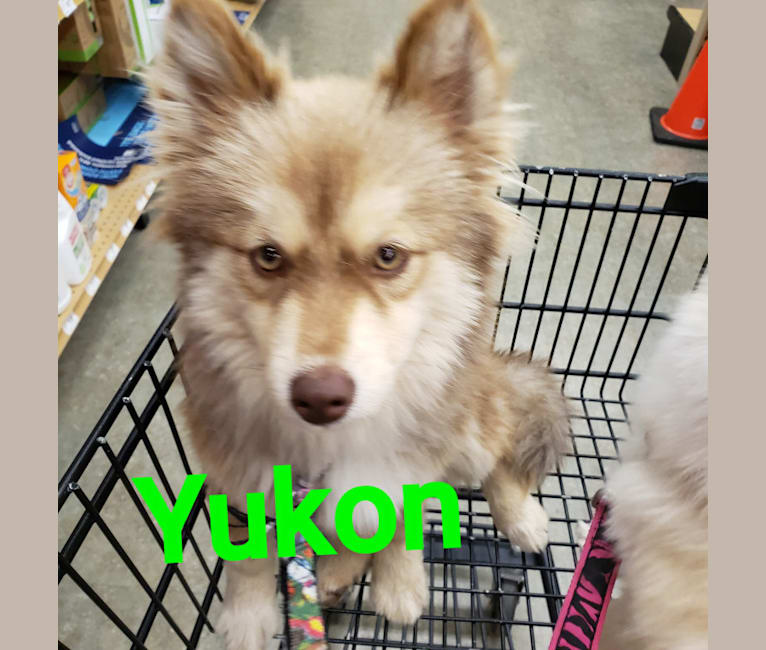Pomskies typically stop growing at around 12 to 18 months of age. Their growth rate may slow down significantly after reaching one year.
Pomskies, the fluffy and energetic crossbreed between the Siberian Husky and the Pomeranian, have won the hearts of many pet enthusiasts. These adorable canines exhibit a wide range of sizes, largely due to their mixed-breed heritage, which can make predicting their adult size a bit challenging.
Generally, owners can expect their Pomsky puppies to reach their full size within a year to a year and a half, with a few individuals taking a little longer to fill out in terms of muscle and girth. Knowing the timeline of your Pomsky’s growth stages can assist in providing the right nutrition and exercise regimen tailored to their developmental needs. With their eye-catching looks and friendly disposition, Pomsky dogs are a popular choice for those seeking a manageable-sized dog with the striking appearance of a Husky.

Credit: www.dog-care-knowledge.com
Meet The Pomsky: A Hybrid Breed
The Pomsky, a cute bundle of joy, has taken the pet world by storm. This hybrid breed combines the fluffy appeal of Pomeranians with the majestic beauty of Huskies. Many pet lovers are eager to know: when does a Pomsky reach its full size?
Pomsky Origins: The Pomeranian And Husky Mix
The Pomsky is the result of a deliberate crossbreeding. This mix aims to meld the compact size of Pomeranians with the solid build of Huskies. It is a breed known for its playfulness and friendly demeanor.
Physical Traits And Characteristics
Pomskies boast a variety of stunning features. Fur colors can range from the Husky’s classic greys to the Pomeranian’s rich browns. Their eyes might sparkle blue or dazzle in amber shades. These dogs usually stop growing between 12 to 15 months of age.
- Size: Medium, between 10 to 15 inches tall at the shoulder.
- Weight: Ranging from 15 to 30 pounds when fully grown.
- Coat: Thick and fluffy, requiring regular grooming.

Credit: www.youtube.com
Pomsky Growth Patterns
Understanding the Pomsky Growth Patterns is fascinating. Pomskies are a mix of Pomeranian and Husky breeds. This blend results in various growth speeds and sizes. Their development involves several stages. The growth of a Pomsky can be broken down into distinct phases. From a tiny pup to a full-grown dog, learn about these critical periods in their growth journey.
Newborn To 3 Months: The Rapid Growth Phase
After birth, Pomskies enter the Rapid Growth Phase. During this stage, they will experience significant physical changes. Here are key points:
- Weight gain is significant each week.
- Eyes and ears open; they start to explore.
- By 3 months, they are much bigger than when they were born.
Pomsky puppies grow quickly in mass and stature. Puppy food and proper care are vital. This phase is crucial for healthy development.
4 To 6 Months: The Transitional Period
The Transitional Period marks a slower pace in growth. During this phase:
- Puppies learn and adapt to their surroundings.
- Their bodies prepare for the next growth stage.
- They continue to gain weight and grow, but not as fast.
Good nutrition and exercise during this time are important. It helps ensure they grow strong and healthy. This period also requires patience as they learn and adapt to training.
When Do Pomskies Reach Their Full Size?
Pomskies, the adorable crossbreed between Siberian Huskies and Pomeranians, charm pet lovers worldwide. One frequent question from Pomsky owners is, “When does my fluffy friend reach its full size?” The growth of a Pomsky varies and it largely depends on various factors including genetics and nutrition.
Typical Age For Pomskies To Stop Growing
The majority of Pomskies reach their adult size around the 12-15 months mark. Some may continue to fill out and gain a bit more weight until they’re about 18 months old.
| Age | Growth Stage |
|---|---|
| 3-6 Months | Rapid Puppy Growth |
| 6-12 Months | Slower Growth Phase |
| 12-18 Months | Reaching Full Size |
Factors That Influence Growth
Several aspects affect a Pomsky’s development. Among these, genetics play the leading role. A Pomsky inheriting more Pomeranian genes could be on the smaller side, whereas more Husky genes might signal a larger size. Nutrition is key too; a balanced diet supports optimal growth. Additionally, activity levels and health can influence how quickly or fully a Pomsky grows.
- Genetics: Determines potential size.
- Nutrition: Influences overall health and growth.
- Activity Level: Impacts muscle development and growth.
- Health: Health conditions can slow or accelerate growth.
Understanding these factors helps owners provide the best care for their Pomskies during their crucial growth phases.
Monitoring Your Pomsky’s Development
Watching your Pomsky grow is an exciting journey! These lively balls of fur bring joy with every growth milestone. Yet, knowing when they reach their full size is key. This section helps pet parents understand their Pomsky’s development stages and what to expect during their growth.
Weight And Height: What To Expect
Pomskies are a mix between Pomeranian and Siberian Husky breeds. Their growth varies widely, with most reaching full size by 12 to 15 months.
| Age | Weight Range | Height Range |
|---|---|---|
| 3 Months | 10-15 lbs | 10-12 inches |
| 6 Months | 15-25 lbs | 12-15 inches |
| 1 Year | 20-30 lbs | 15-18 inches |
Track your Pomsky’s weight and height monthly. Ensure they align with healthy growth charts.
Health Checks: Keeping Up With Vet Visits
Regular vet visits are crucial. They ensure your Pomsky’s growth is on the right track.
- Vaccinations
- Growth assessments
- Dental hygiene checks
- Diet and nutrition advice
Sticking to a vet-approved schedule keeps your furry friend healthy and happy.
Supporting Your Pomsky’s Growth
Curious about your Pomsky pup’s growth? Supporting your Pomsky’s growth from puppyhood to adulthood requires attention to their nutritional and exercise needs. With a lifespan of increasing joy, it’s crucial to give them the best start in life. This section ensures you know exactly how to support your Pomsky throughout their growing phase.
Balanced Nutrition For Optimal Development
Mealtime matters for growing Pomskies. They need the right balance of nutrients for healthy development. Ensure you are feeding them high-quality food designed for puppies. This provides the correct ratio of protein, fats, and carbohydrates.
- Proteins – build muscles and repair tissues
- Fats – essential for energy and cell growth
- Carbohydrates – provide ongoing energy and fiber
- Vitamins and minerals – needed for bone health and immunity
Consult with your vet for tailored advice. They can recommend the best diet for your dog’s unique growth needs. Feeding guidelines change as they grow. Keep a close eye on portion sizes and frequency.
Exercise Requirements For Growing Pomskies
Exercise is just as important as diet. Pomskies need regular physical activity to develop strong muscles and bones.
Remember, too much can harm their growing joints. Stick to moderate, playful activities until they’re fully grown.
- Short walks – keeps joints moving without too much strain
- Playtime – fetch and gentle tug-of-war boost fitness and bond
- Training sessions – mental exercise is just as vital as physical
Workouts should be fun and safe. Watch your Pomsky for signs of tiredness or soreness and give them time to rest.
Credit: www.tiktok.com
Recognizing The Signs Of Maturation
The Pomsky, a delightful crossbreed between the Pomeranian and the Siberian Husky, charms pet owners worldwide. This dog breed is famous for its playful spirit and foxy façade. Recognizing when a Pomsky stops growing is crucial to understand their development. A Pomsky’s growth typically slows down and eventually stops as they reach maturation. This phase includes noticeable behavioral shifts and physical transformations.
Behavioral Changes In Adult Pomskies
As Pomskies grow, their behavior provides significant clues to their maturity. Owners might observe:
- A decrease in hyperactivity.
- More consistent obedience.
- Stabilization in temperament.
- A shift towards a more routine sleeping pattern.
These signals suggest your Pomsky may be crossing the threshold from playful pup to composed adult.
Physical Indicators Of Maturity
Physical growth markers are telling signs of a Pomsky’s maturation.
| Age Range | Expected Changes |
|---|---|
| 12-18 Months | First, the cessation of bone growth occurs. |
| 18-24 Months | Then, muscle development finalizes, solidifying their physique. |
Look for a halt in height increase and check with your vet to confirm if growth plates have closed—a definitive sign of maturity.
Frequently Asked Questions For When Do Pomsky Stop Growing
When Do Pomsky Puppies Reach Full Size?
Pomsky puppies generally reach their full size by the age of 1 to 1. 5 years. As a designer breed, their final size can be influenced by their parentage, with some growing larger if they have a higher percentage of Husky genes.
How Big Do Pomskies Get When Fully Grown?
An adult Pomsky typically weighs between 15 to 30 pounds and stands around 10 to 15 inches tall at the shoulder. However, their size can vary depending on the specific mix and traits of their Siberian Husky and Pomeranian parents.
What Factors Affect Pomsky Growth?
Several factors affect Pomsky growth including genetics, diet, and exercise. A balanced diet and regular exercise are crucial for healthy development, while genetics will determine their maximum potential size.
Are Pomskies Considered A Small Or Medium Breed?
Pomskies are generally considered to be a small to medium breed. Their classification can depend on which side of the parentage they lean more towards, the smaller Pomeranian or the larger Husky.
Conclusion
Understanding your Pomsky’s growth timeline can set the stage for a healthy, happy life together. Typically, these pups reach their full size by 12 to 18 months. By tracking their progress and consulting your vet, you’ll ensure your furry friend thrives.
Remember, proper nutrition, exercise, and love are key to their well-being as they grow.

